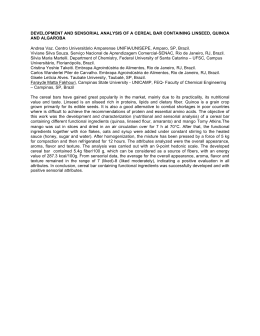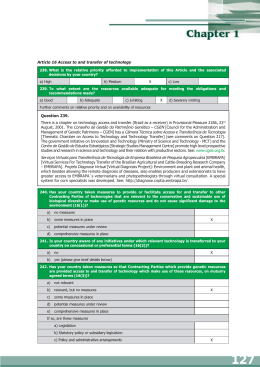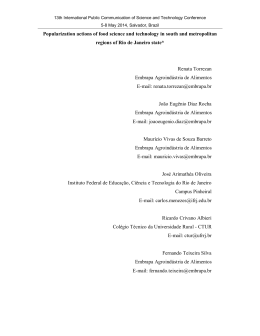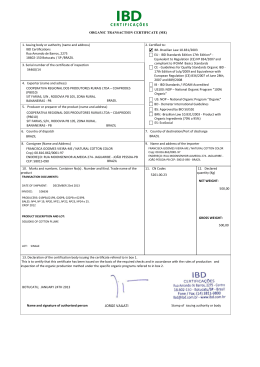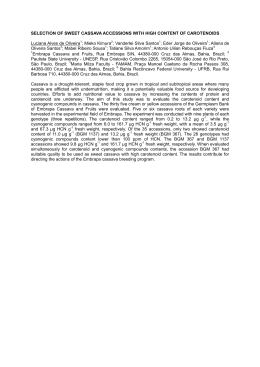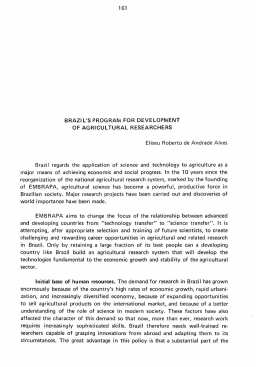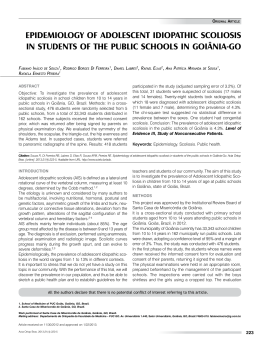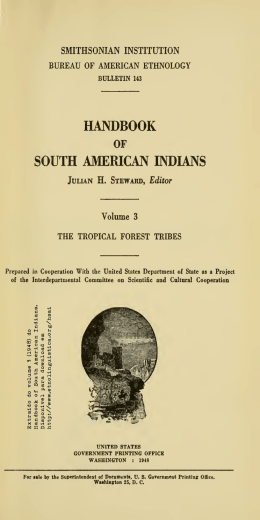Herpetological Review PODOCNEMIS EXPANSA (Giant South American River Turtle) NESTING RANGE ExPANSION JOSÉ RObeRtO mOReiRA, embrapa recursos Genéticos e Biotecnologia, Parque estação Biológica - PqeB - av. w5 Norte (final), Brasília, Distrito federal, Brazil, 70.770-917 (e-mail: [email protected]); RAfAel AntÔniO mAchAdO bAleStRA, Centro Nacional de Pesquisa e Conservação de répteis e anfíbios (raN), rua 229, nº 95, setor leste universitário, Goiânia, Goiás, Brazil, 74.605-090 (e-mail: [email protected]); fÁbiO de OliveiRA fReitAS, embrapa recursos Genéticos e Biotecnologia, Parque estação Biológica - PqeB - av. w5 Norte (final), Brasília, Distrito federal, Brazil, 70.770-917 (e-mail: [email protected]. br); AnA pAulA GOmeS luStOSA, Centro Nacional de Pesquisa e Conservação de répteis e anfíbios (raN), rua 229, nº 95, setor leste universitário, Goiânia, Goiás, Brazil, 74.605-090 (e-mail: [email protected]); ARtuR JORdÃO de mAGAlhÃeS ROSA, embrapa Cerrados, Br 020 Km 18, Planaltina, Distrito federal, Brazil, 73.310-970 (e-mail: artur.rosa@cpac. embrapa.br); AntÔniO AlencAR SAmpAiO, Centro Nacional de Pesquisa e Conservação de répteis e anfíbios (raN), rua 229, nº 95, setor leste universitário, Goiânia, Goiás, Brazil, 74.605-090 (e-mail: antonio.sampaio@ icmbio.gov.br); pAulO diAS feRReiRA JúniOR, Centro universitário Vila Velha, rua Comissário José Dantas de melo, 21, Vila Velha, espírito santo, Brazil, 29.102-770 (e-mail: [email protected]). Natural History Notes PODOCNEMIS EXPANSA (Giant South American River Turtle). NESTING RANGE EXPANSION. Podocnemis expansa is gregarious during nesting; even today, beaches are found in the Brazilian Amazon where hundreds of females might lay their eggs in a single night. The high consumption of this turtle’s meat and eggs, as well as the ease with which it is captured, especially during nesting periods, has contributed to the decline in populations throughout its entire range and to extirpation in some places. Despite conservation and enforcement efforts, the species has been classified by the IUCN SSC FTTG as Critically Endangered (October 2010) (www.iucnredlist.org). Areas with high concentrations are well known, but regions at the limits of its range, where there are few individuals, are not yet completely known, partly due to difficult access and the extensive area where the species occurs. In the Lower Xingu River there are known nesting sites for P. expansa, most notably on Embaubal beach (2.6784°S, 52.0186°W), in Senador José Porfírio (Pará state), but information is still lacking on the species’ occurrence throughout this hydrographic basin. Here we report the first occurrence of P. expansa in the Upper Xingu River, although regional studies have indicated that this area is a potential habitat for the species (Pritchard and Trebbau 1984. The Turtles of Venezuela. Society for the Study of Amphibians and Reptiles, Caracas. 403 pp.). In 2010 we recorded and monitored the temperature of two P. expansa nests in the Xingu Indigenous Park (11.9346°S, 53.5298°W). These were the only nests found on the sandy beaches that are formed during the river’s dry season throughout a monitored area of 13 km where Podocnemis unifilis frequently nests, and Phrynops geoffroanus do so less often. Nesting of P. unifilis in this area has been monitored since 2006, but it was only in 2010 that P. expansa nests were seen. Podocnemis expansa nesting occurred when the water level reached its lowest point, which is standard for this species. We used data loggers (Ibuttons Maxim DSG1921G) to monitor the temperature throughout incubation, at 60-minute 595 intervals. For the two nests, incubation lasted 65 and 78 days and the thermo-sensitive-period temperature (in the second third of the incubation period) was 29.4 ± 0.86°C (range = 28–31°C) and 28.7 ± 1.01°C (range = 26.5–32°C), respectively. These incubation temperatures and durations are compatible with the production of males (Lubiana and Ferreira Júnior 2009. Zoologia 26:527– 533). Hatching success was 57% in one nest with 101 eggs and 52% in the other nest with 73 eggs. No predation attempts were recorded for the nests. On 29 October 2010, a female was captured by one of the Indians while fishing with a hook and line near the same beach where the two nests were found. This female had a straight carapace length of 33.6 cm, straight carapace width of 25.5 cm, plastron length of 28.1 cm, plastron width of 19.8 cm and weight of 3.38 kg. Tissue was collected from this individual for comparative genetic analysis with individuals from other regions in the future. The Indians confirmed that they do occasionally capture P. expansa when fishing. During the same incubation period in 2010 our group also saw P. expansa tracks on at least two other beaches in the area. Reports from indigenous people suggest that P. expansa was introduced in the 1960s, when the Xingu Indigenous Park was created, by its founders and some indigenous people. These animals came from populations on the Ilha do Bananal, in the Araguaia River, in São Felix do Araguaia (Mato Grosso state). The animals were released at about 20 km upstream from the site where we observed the nests. Their introduction had been to provide an additional food source, mainly because the Indians of that region very much appreciate the meat and eggs of P. unifilis. In the 1980s a new release of young P. expansa took place in rivers in the Upper Xingu. This time the individuals were from Rio das Mortes (Mato Grosso) (Vera Lúcia Ferreira Luz, Environmental Analyst, Head of RAN/ICMBio, pers. comm.). On both occasions the translocation of animals was carried out without considering the species’ ecological needs and without approval from the relevant environmental entities. There are various signs that the information about the introduction of the species may be reliable: the apparent rarity of P. expansa in the region; the lack of knowledge among the indigenous peoples of the nests and nesting sites; few reports of adult individuals being captured; scant knowledge of the capture techniques used for the species; the fact that this species is not part of the traditional indigenous diet (while P. unifilis, common in the area, is an important food item); and the absence of this species in local myths and rites. Knowledge of all nesting sites is important for the establishment of the species’ range, especially in regions that have been only lightly affected by agricultural inroads and intensive fishing. The report of P. expansa in the Xingu Indigenous Park is important because of the large changes foreseen with the damming of the Xingu River to generate energy. Hydroelectric plants are planned upstream and downstream of this recorded site, and it is vital that the feeding and nesting areas of the species are known, to study the possible effects on their ecology caused by the change in the river’s hydric regime. The genetic diversity of these individuals should be compared with that of turtles from other areas (principally in populations from the Lower Xingu and Araguaia River Basin). This will lead to a better understanding of the evolutionary dynamic of the species in the reported site and of its diversity distribution within this area at the limit of its range. This work was licensed by RAN/IBAMA (Process SISBIO Number: 16226-4, Emitted: 14/07/2010) and sponsored by Projeto Petrobras Ambiental (Contract 6000.0053598.09.2). Herpetological Review 42(4), 2011 596 Natural History Notes JOSÉ ROBERTO MOREIRA, Embrapa Recursos Genéticos e Biotecnologia, Parque Estação Biológica - PqEB - Av. W5 Norte (final), Brasília, Distrito Federal, Brazil, 70.770-917 (e-mail: [email protected]); RAFAEL ANTÔNIO MACHADO BALESTRA, Centro Nacional de Pesquisa e Conservação de Répteis e Anfíbios (RAN), Rua 229, nº 95, Setor Leste Universitário, Goiânia, Goiás, Brazil, 74.605-090 (e-mail: [email protected]); FÁBIO DE OLIVEIRA FREITAS, Embrapa Recursos Genéticos e Biotecnologia, Parque Estação Biológica - PqEB - Av. W5 Norte (final), Brasília, Distrito Federal, Brazil, 70.770-917 (e-mail: [email protected]. br); ANA PAULA GOMES LUSTOSA, Centro Nacional de Pesquisa e Conservação de Répteis e Anfíbios (RAN), Rua 229, nº 95, Setor Leste Universitário, Goiânia, Goiás, Brazil, 74.605-090 (e-mail: [email protected]); ARTUR JORDÃO DE MAGALHÃES ROSA, Embrapa Cerrados, BR 020 Km 18, Planaltina, Distrito Federal, Brazil, 73.310-970 (e-mail: artur.rosa@cpac. embrapa.br); ANTÔNIO ALENCAR SAMPAIO, Centro Nacional de Pesquisa e Conservação de Répteis e Anfíbios (RAN), Rua 229, nº 95, Setor Leste Universitário, Goiânia, Goiás, Brazil, 74.605-090 (e-mail: antonio.sampaio@ icmbio.gov.br); PAULO DIAS FERREIRA JÚNIOR, Centro Universitário Vila Velha, Rua Comissário José Dantas de Melo, 21, Vila Velha, Espírito Santo, Brazil, 29.102-770 (e-mail: [email protected]). CROCODYLIA — CROCODILIANS Herpetological Review 42(4), 2011
Download
